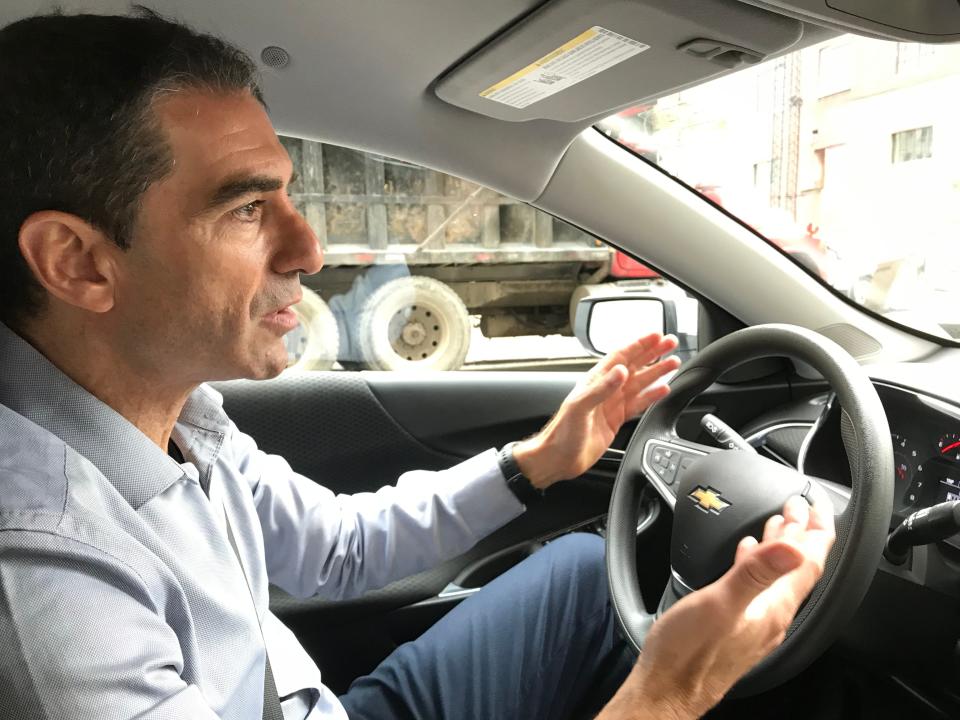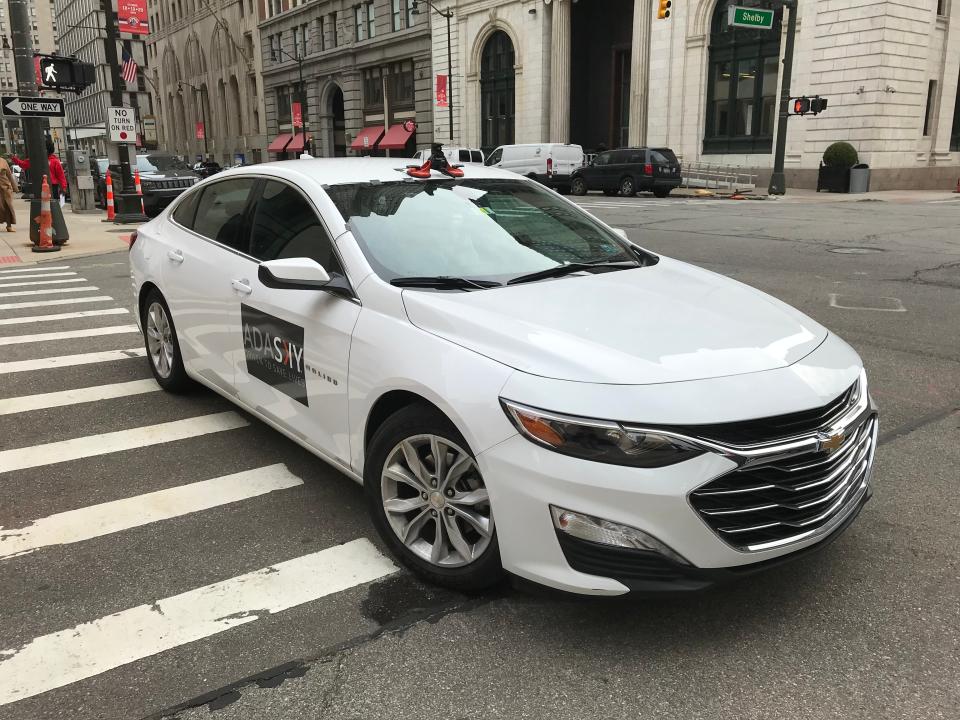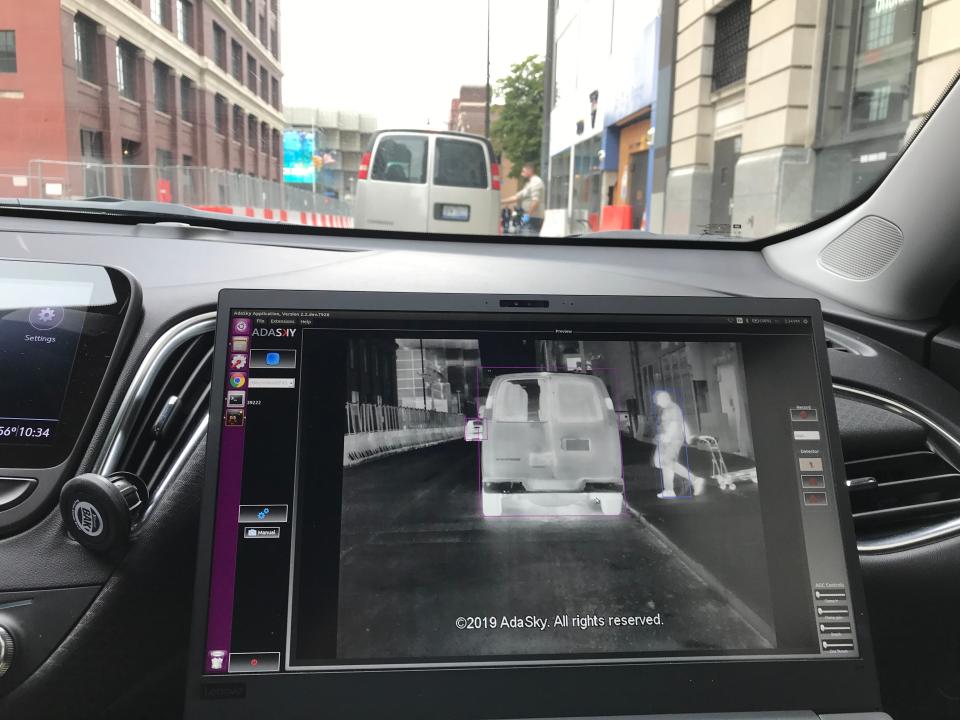Thermal camera demo shows new tool in fight to make driverless cars safer

DETROIT – Raz Peleg is looking for the right amount of steam in downtown Detroit.
He’s trying to show what image a special camera small enough to fit in the palm of a hand and made by an Israeli startup can capture when it’s mounted on a car, in this case a white Chevy Malibu.
The person he’s sent down the street for this recent demonstration glows luminously on a laptop screen inside the car. It’s the same with other bystanders nearby, including a man in the back of a box truck.
The steam, clearly visible through the car’s windows, billows up from the street, but the humans always stand out, which is the point. Drivers in cars equipped with the cameras won't see these images, but they would inform the safety technology in the vehicles, including possibly a U.S. pickup manufacturer in the coming years.
“We’re going to save lives, and not far away into the future,” Peleg says.
Peleg, sales manager for AdaSky, a 60-person operation based in the north of Israel, is showing what the company’s thermal camera can do. It's technology that could fill in the gaps left by lidar, radar and standard cameras, long promoted by many in the industry as a necessary three-pronged approach for autonomous vehicle development. Self-driving cars aside, it also could help tackle the country's pedestrian death crisis.

To Peleg, who flew F-16s for the Israeli Air Force, the company’s thermal sensing cameras could help advanced driver assistance systems save lives by offering technology that works in conditions that trip up other types of sensors, and is cheaper. (Peleg said the cameras would cost several hundred dollars.)
The company says its thermal cameras passively detect heat from objects, people and animals, giving them an edge over other sensors in dark and bad weather.
Black Friday: Shoppers flock to stores early for deals
Don't forget Cyber Monday: Walmart announces deals with savings on TVs, laptop, toys and more
Seeing in the rain
That difference was on display in some side-by-side videos – AdaSky's thermal camera versus an ultra-high-definition camera – the company provided of a rainy nighttime drive in Detroit. Pedestrians are clearly visible with the thermal camera video, something that can't always be said for the other video.
If the technology works as it did during a recent demonstration for the Free Press in Detroit, it could be a weapon in the fight to reduce the staggering number of pedestrian deaths every year in the United States. Those deaths, of people walking on or near U.S. roads, increased by 3.4% in 2018, to 6,283, even as the overall traffic death toll dropped 2.4% to 36,560 from the year before, according to the National Highway Traffic Safety Administration.

The pedestrian death crisis was the subject last year of a Detroit Free Press/USA Today investigation, titled “Death on Foot: America’s love of SUVs is killing pedestrians,” which highlighted the role vehicles with higher and blunter front ends play in the crisis.
More: Death on foot: America's love of SUVs is killing pedestrians
More: Pedestrian detection systems didn't stop 4 cars from slamming test dummies
More: Senators demand answers on the safety of self-driving cars
During his drive around Detroit, Peleg recounted a story about a lidar presentation he saw at a German auto show. The presenter, under questioning, acknowledged that the system struggles when confronted with rain, an admission that Peleg found troubling.
“That’s not acceptable that some mobility service will work only in nice weather,” Peleg said.
Lidar, a sensing system usually seen spinning atop autonomous test vehicles, bounces lasers off an object to create an image.
Cameras also struggle in the rain. Anyone familiar with the generally well-regarded Subaru EyeSight system has probably had it stop working in a heavy rain. Peleg said the system in a Ford Fusion he was driving recently became inoperative during a downpour.

Those struggles have implications for pedestrian detection systems.
The limitations of current such systems were on display in the results of a AAA study released in October. Four different model cars slammed into pedestrian dummies under various conditions.
“As the AAA report just weeks ago stated pedestrian detection, automatic braking in the market today do not work in too many cases,” Peleg said. “As (advanced driver assistance systems) are paving the way to autonomy, it should work in all weather situations and all times.”
Avoiding deer crashes, too
NHTSA has indicated that pedestrian detection will be more of a focus in the future, pledging to update the New Car Assessment Program in 2020 and to “consider new technologies tied to the safety of pedestrians and other vulnerable road users.”
But pedestrians aren’t the only potential beneficiaries of a technology that might better detect living creatures near roadways.
Peleg said the cameras could help reduce the estimated 50,000 vehicle-deer crashes in Michigan every year.
“Whether it’s a cow or a deer, we recognize them,” Peleg said.
Sam Abuelsamid, principal analyst for Navigant Research and an expert in this arena, also had the chance to see the AdaSky demonstration, although at a different time than the Free Press, and he was complimentary.
“I think it’s an important technology that should probably be part of ADAS systems and automated driving systems going forward. It provides a different view of the world from what you can get from traditional imaging cameras,” said Abuelsamid, noting that he has seen similar technology from FLIR Systems, an Oregon-based thermal sensing company.

Despite the potential competition, the presence of two companies in this automotive space should not be a problem, Abuelsamid said, noting that automakers would likely want to have multiple suppliers available.
AdaSky is expecting to supply its cameras to a U.S. pickup manufacturer in the next year, although Peleg declined to reveal the name.
The company does have a relationship with Magneti Marelli, the components company that Fiat Chrysler Automobiles sold earlier this year.
A demonstration at CES in January featured AdaSKy’s cameras incorporated into a Magneti Marelli platform. The cameras were in the headlights, which is a switch from the typical placement in the grille for such sensors, the company noted.
“Integration in the headlamp means the sensor is in closer proximity to other sensors, which enables better fusion. Sensor protection and cleaning is easier to maintain as well,” according to an AdaSky news release in January.
Contact Eric D. Lawrence: elawrence@freepress.com or (313) 223-4272. Follow him on Twitter: @_ericdlawrence.
This article originally appeared on Detroit Free Press: Drive with thermal camera shows new tool to make driverless cars safer

 Yahoo Finance
Yahoo Finance 